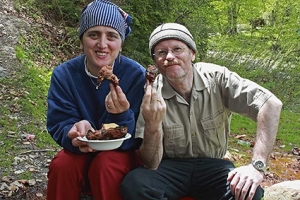Racha, Really
I’m writing this from Tbilisi, a day before I return home to Etseri in Upper Svaneti. My wife is waiting for me there, and it’s a good time to recall a trip we took together to her ancestral homeland.
The Skhirtladzes are from this province, and Lali is one of them, although she was born and raised in Kakheti. Our honeymoon, in May 2009, gave us the opportunity to go to Racha, just east of Svaneti. First stop, its capital: Oni.
Insert a joke. A guy gets into a taxi in Racha. “Is it far to Oni?” he asks. “No,” says the driver. An hour later: “I thought you said it wasn’t far!” “Well, it’s far now...”
The Jewish synagogue, and the museum, in Oni were treasures. The former was locked but we could see it from outside and peer through the windows of what used to be a much more thriving house of worship than it is today. Evidence to support the claim that the Jews were comfortable in Georgia, as seems to have been the case since about 2500 BC.
Oni’s museum, in 2009, was still not in prime condition for housing and showing the items it contains. But at least it was open, and allowed photography. Some of the ancient art I found there was wonderfully “primitive,” or in the style of folk art, while one wood carving reminded me more of an extraterrestrial being than anything else. Curiouser and curiouser.
We walked to Mravldzali next, the Skhirtladzes’ actual home village, at about 2000 m above sea level claiming to be the second highest village in Georgia (after Ushguli). Here, Lali’s light croc shoes, which she’d had for a few years already, shone. It was 10 km up, nary a downhill, on a road mostly of rock; overnight with her delighted relatives; and then the same distance coming down the next day. The crocs are still going strong as I write this, as is their wearer. The clan have an annual gathering here at about the time of Mariamoba, the Feast of the Virgin Mary, at the end of August. One day we must attend this.
We were also able to go further north, closer to the Russian border, to see mineral springs, forests, a picnic location which we made use of for making mtsvadi (shish kebabs), and more of the fantastic mountain scenery which is the whole point of Racha. It isn’t nearly as well known as a tourist destination as Svaneti is, but there is as much beauty here as anywhere in diverse Georgia. Everywhere you go, there’s something different and glorious.
Another thing for which Racha is famous is its small output of Khvanchkara red wine, from grapes found in one small place near Ambrolauri. Rich, highly sought after, unmatched; unique to the place due to the special combination of the vines’ variety itself, as well as the soil and climate.
Vittorio Sella’s late 19th century photographs of this region display a surprising amount of Svan watchtowers among the villages of certain parts. Apparently land changed hands; few of these towers now remain, sadly, victims of neglect or perhaps deliberate attempts to cover over part of history and let it lie.
I know that I have only scratched the surface of Racha; what could one expect of a few days’ trip?! We came away with a cowbell which I had found on the Mravldzali road, nice melodious souvenir, which finally our cow has started wearing these six years later for when I need to find her on the faraway summer mountain grazes. It’s made from an old car part, I think, so nothing ancient. But it works well, and I always know it’s hers.
A more through exploration awaits us. There are even hiking trails connecting Racha and Upper Svaneti, and many more villages to discover or examine. Like the rest of Georgia, Racha will bountifully reward such study, displaying its charms for all the senses to appreciate. Take your time; this is the spirit of a local people who are not known as hasty. You won’t regret it.
Tony Hanmer runs the “Svaneti Renaissance” Facebook group, now with over 1100 members, at
www.facebook.com/groups/SvanetiRenaissance/ .
He and his wife also run their own guest house in Etseri:
www.facebook.com/hanmer.house.svaneti
Tony Hanmer











